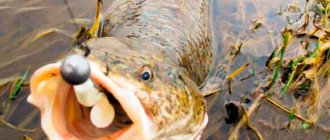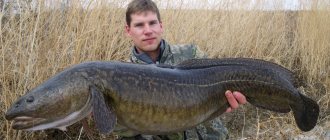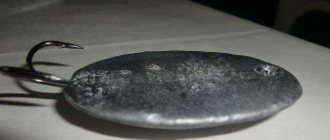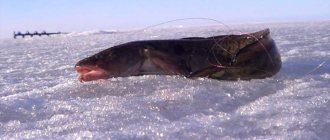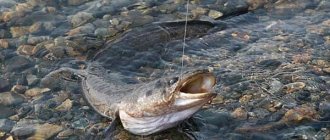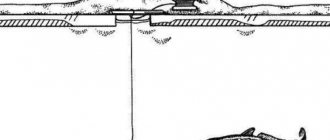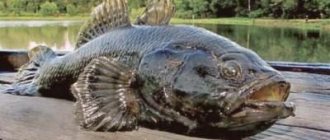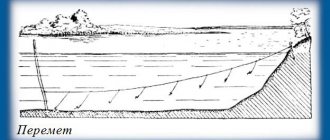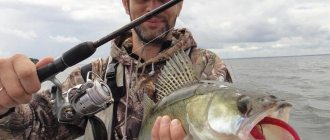All autumn, right up to the freeze-up, we caught burbot very well. But then the edges appeared on the Oka, then there was slush, and finally the river stood up. How is our hero, burbot, doing?
And he's doing great. Actively feeds, moving around its hunting grounds, remaining a voracious predator before, during and after spawning, which occurs in mid-January.
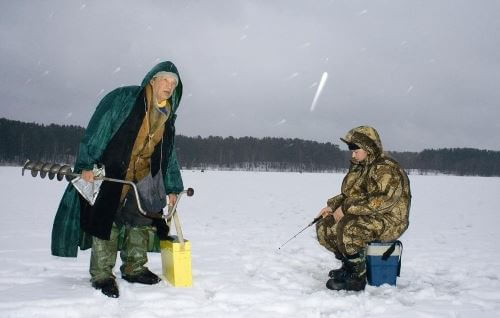
If the winter turns out to be little snow or the river rises before heavy snowfalls, then you can get to the place where I fish by any car; later, all-wheel drive has an advantage, and as the snow cover grows, it may even come down to a snowmobile. Since my places for ice fishing for burbot are located only 10–15 km from the city, I prefer wide hunting skis to all types of transport.
Ice safety
Ice on a navigable river is much more dangerous than on any closed body of water. Before starting fishing, especially on the first and last ice, it is necessary to thoroughly check the thickness of the ice in the fishing area and make sure that there are no gullies covered with snow or covered with a thin layer of ice.
We do it as follows. We fasten a safety rope (preferably a rope for mountaineering) on the shore to a tree or strong bush, and tie the other end to the angler who goes to check the ice. It is best to go night fishing with a reliable friend who will provide insurance on the shore. Drill holes throughout the fishing area in all directions.
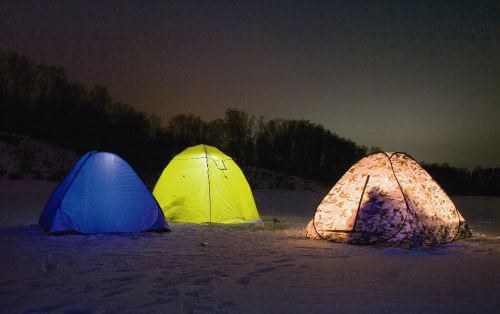
You need to go through it all the way so that there is no doubt about the safety of the ice. Having done this, you can safely start fishing. The safety rope remains on the ice until the end of fishing.
It’s not for nothing that I talk so much about safety. Falling through the ice on a river is much more dangerous than in a stagnant body of water - the current can drag you under the ice very quickly. When fishing at night, this is doubly dangerous. Keep the risk to a minimum, then there will be many more fishing trips ahead.
Fishing place
Looking for burbot camping sites under the ice in winter is a futile endeavor. It is almost impossible to determine whether there is burbot here. But there is one wonderful rule that is worth keeping in mind: where burbot was caught before the freeze-up, it will graze after the river is covered with ice. Calm currents, average depth, hard bottom and gentle shore - these are the main criteria for finding places where burbot hunts. Where you fished in the fall, go there for ice fishing.
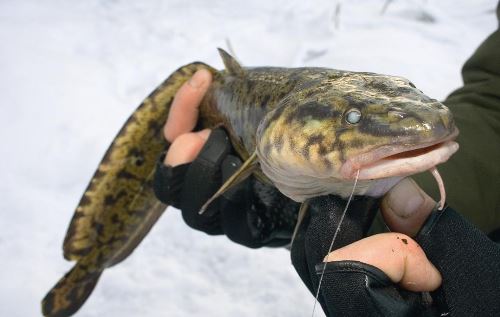
In addition to the Oka, in our area there are a large number of small rivers where there is quite a lot of burbot.
Tackle for burbot in winter
There are many ways to catch burbot from the ice, but mainly it is fishing using natural and artificial baits. You can use both at the same time, that’s exactly how we started, but over time we still gave preference to fishing with artificial bait as the most sporting, gambling and mining method.
The rod should not be short, since it is inconvenient to carry out rather complex bait play. It must be very sensitive so that the angler can see or feel the bite, fit comfortably in the hand and have sufficient strength necessary for fishing.
Everyone can choose a reel according to their taste; I use a low-profile Tica Sculptor multiplier. This reel has excellent sensitivity, is ergonomic, comfortable, behaves well at low temperatures, in a word, it meets all the requirements that can be placed on a reel for winter burbot fishing.
The fishing line you will need is monofilament with a diameter of 0.25–0.28 mm or braided, which increases the sensitivity of the gear. I recommend FireLine cord with a thickness of 0.15 mm; it is sold in 44 m reels and is much cheaper than its 135 m summer counterpart.
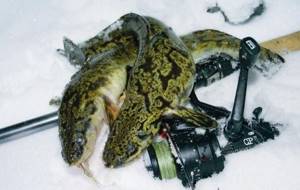
The bait we are fishing with now is a fairly simple design, but it took a lot of time before we used it. When we started catching burbot from the ice, we lowered every conceivable and inconceivable bait into the holes, including wobblers. But in the end they found one that the burbot liked.
It is somewhat reminiscent of a dead fish rig, but slightly modified and modified for artificial bait. A structure made of soft wire for attaching a silicone bait and two pieces of monofilament fishing line or braided cord of different lengths are attached to the “Cheburashka” sinker, to which tees corresponding to the size of the bait are tied.
When I go fishing, I take a set of weights from 10 to 35 g, and on a pond I select the required weight depending on the depth and strength of the current to ensure proper movement of the bait along the bottom. In the places where I fish, 15-25 gram weights are optimal. Tees are fixed in the body of the bait with one or two hooks out of three.
If the bait is too bulky, you can put three tees. Burbot attacks slowly and carefully, and an additional hook will not be superfluous. Any silicone bait is suitable: a worm, a twister, a small vibrotail, an imitation of a frog or crayfish.
I prefer crayfish (and, in my opinion, burbot too); it has many legs, antennae, claws, and all this plays, moves and forces the burbot to attack. The size of the bait should be selected experimentally, but, as a rule, burbot are more interested in small and medium-sized ones.
Sometimes the bait can be modified: for example, part of the body of a twister that is too large can be cut off, and the large tail that plays in the current can be left entirely. You can start with 4-5 cm twisters, but do not forget about larger baits - often burbot bites more actively on a large bait than on a small one.
We did not notice the influence of the color of the bait on the intensity of the bite. At night under the ice, at a depth of 1.5–2 m, it is probably difficult even for burbot to see the color, and the shape and action of the bait are still decisive.
It's a good idea to use the Mega Strike bite activator. The burbot does not let the bait it treats out of its mouth noticeably longer, which increases the chances of a successful hooking.
The articulated connection of the bait with the sinker allows it to be more “alive”. It is better to install the equipment in advance, since it is more difficult to do this at night in the cold with the light of a headlamp.
You can fish with a simple jig rig, but in this case there are fewer bites and a lot of empty hooks.
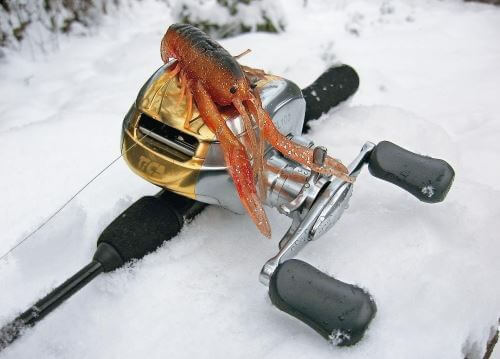
Equipment for catching burbot on the Oka
The most common gear used for catching burbot not only on the Oka River, but also on other bodies of water, is a bottom fishing rod. The basic design of this gear remains the same regardless of where you are fishing. The river is famous for its fast flow, for this reason it is necessary to be especially careful in choosing the appropriate sinker. The best way is to use a sinker whose weight ranges from 100 to 150 grams. In this case, the bait will remain exactly in the place where you threw the tackle, and it will not be carried away by the current.
It is also necessary to pay attention that the Oka is a fairly deep river, so it is necessary to take skeins of fishing line with a sufficiently large reserve. Experienced fishermen recommend using reels with at least 10 meters of fishing line. In this case, you will not be tied to one place on the river, but will be able to move freely in search of the best place for fishing. Don't forget to equip your donk with a bell and glow stick.
Read: Bait for burbot in autumn
When making tackle, you need to pay attention to the fact that burbot is an extremely large and strong fish. Therefore, the fishing line must also be strong. The cross-sectional diameter of the fishing line must be at least 0.3 millimeters. Otherwise, you may miss your catch, which you will regret for a very long time. Trophy burbots are not found so often anymore.
Fishing technique and tactics
Wiring is carried out as follows. As soon as the sinker touches the bottom, they begin to slowly release the cord, trying to release the bait 4–5 m from the hole, but no further, since this significantly weakens the sensitivity of the tackle.
Then slowly, 5–10 cm at a time, they begin to reel in the bait, pausing for 10–15 seconds, during which they slightly play with the rod: they barely noticeably release it or reel it in. Sometimes very minor changes in wiring lead to an increase in bites. It happens that bites occur when you play with the bait like an ordinary jig.
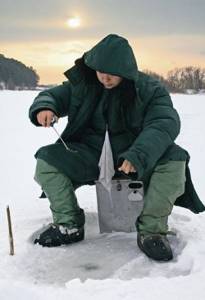
The holes should be positioned taking into account the fact that the bait has a fairly large working area. I drill holes in the direction from the shore at a distance of 50–70 cm from each other, and along the coastline - every 4–5 m.
If a bite occurs, you should linger at this place, then fish nearby holes and generally return to the “working” holes more often. It happens that from two or three holes it is possible to catch four to six burbots, and from the rest - nothing.
The bite of burbot can be different: from a slightly noticeable trembling of the rod tip to a feeling of heaviness in the hand.
The hook should not be lightning fast and sharp, but rather long and drawn out. There is no need to rush into fishing, since burbot is a weak fighter and behaves calmly when hooked; You should only be wary of the lower edge of the ice: contact of the cord with it under load sometimes leads to the line breaking.
A hook is sometimes necessary. Although you won’t find giants from the cod family in the Oka, if the burbot uses its favorite technique - curling up into a donut in front of the hole, you can’t do without a hook. But with specimens over 2 kg and without burbot “tricks” you have to tinker.
Getting to know the fishing object
The individual has a spindle-shaped body, covered with small scales and tapering towards the tail, a small flattened head with bulging eyes. The upper jaw is larger than the lower jaw. The main distinguishing characteristic is the long mustache on the lower jaw. The fish can reach 1.2 m in length and weigh 24 kg.
Features of behavior . Burbot prefers to live in clean waters with a rocky bottom and a pronounced current. It can be found in holes, near stones, snags, and in the roots of trees growing near water. The optimal period for fishing occurs when the water temperature is no higher than 12-13 degrees Celsius. At 15 degrees Celsius, the activity of the individual decreases sharply, and it seeks shelter at the bottom, where it waits out the heat.
Spawning time occurs in December and January; the fish bite is weak at this time. It is extremely rare that they are caught on a hook, and even then they are small, immature specimens.
In the autumn, the burbot begins to eat, and it is very active . When hunting, this predator uses almost no vision, relying only on the smell of prey and information received through the lateral line.
Baits and groundbait
Burbot is a predator, so both bait and groundbait must be made from live ingredients. In this capacity they mainly serve:
- maggot,
- bloodworm,
- red dung worms and crawling,
- pieces of fish,
- live bait or live frog,
- chicken giblets.
Fishing time
If in late autumn the burbot bite does not begin immediately with the onset of darkness, then when ice fishing this fish begins to be caught already at dusk and the bite with varying intensity continues for 5–6 hours, and then the predator completely stops taking. Only before dawn can burbot pamper you a little with bites. Therefore, it is completely impractical to stay on the river all night, which at this time of year is much longer than the day.
We usually go out on the ice one and a half to two hours before dark, and sometimes the burbot already shows itself by biting. It is often possible to catch pike perch.
Lures
Burbot on the Yenisei and other rivers perfectly accept bait of animal origin; plant options will leave it indifferent. To ensure that the trophy specimen does not pass by, it is advisable to take several types of bait with you, this way you will definitely be able to interest the cod brother.
The best bait for burbot in October, according to experienced fishermen, is:
- live bait;
- piece of fish;
- leeches;
- frogs;
- crawls;
- dung worms;
- insect larvae;
- small crustaceans;
- chicken liver.
Burbot is excellent for catching on shrimp, and gudgeon is considered a delicacy for it. In most cases, several donks with different baits are placed, and the fish’s preferences are determined by the bites.
Fishing with live bait
This method will be successful in catching burbot on the Volga, but small bodies of water are also not far behind. Live bait is a universal type of bait for burbot; it works always and everywhere if the freshwater cod brother lives in the reservoir.
It is best to use fish caught in the same body of water as bait; burbot will not pass by:
- minnows;
- ruffs;
- perches.
These three options work exclusively, but sometimes burbot may prefer only one species, and this depends on the reservoir itself.
Fishing for burbot using the liver
This type of bait also perfectly attracts the cod brother; an important indicator will be the freshness of the product used. If it has a slight odor, then burbot can avoid it, but catfish will covet it.
The ideal option would be to fish with chicken liver; he definitely won’t miss this delicacy.
The liver must be prepared for fishing; it is placed in a bag and the whole piece is taken with you on a fishing trip. Cut into strips immediately before baiting the hook.
Fishing with a worm
It’s good to catch a worm in the autumn, and crawling is preferable to its dung counterpart. For fishing, not one, but several worms are used at once. No more than two crawlers are planted to catch an average-sized burbot, and a bunch of dung can contain five.
It is precisely the bunching of bait on the hook that will allow you to drive away small things from the hook, which will also want to feast on the offered delicacies. Burbot will be able to swallow such a delicacy without problems, so you can safely put several worms on the hook at once.
Fishing ethics
In the fall, when we catch burbot from the shore and use natural baits, we sometimes have to not let go of small fish - burbot is greedy and swallows hooks in such a way that, even using special devices, it is impossible to remove them without injuring the fish.
When ice fishing, things are different. The burbot should not be allowed to swallow the bait deeply, otherwise he will understand that what he has in his mouth is not a tasty frog, but the silicone you slipped. Therefore, when fishing with artificial bait, the hooks are almost always set at the edge of the burbot's mouth.
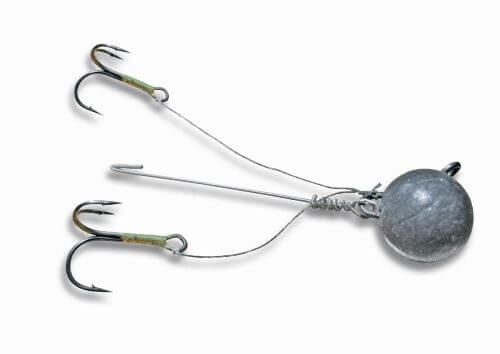
Based on this, I urge you to release burbots, the size of which is not worthy of being considered prey. There is more burbot in the rivers of the central zone every year; he is not afraid of nets and electric fishing rods, and he has few natural enemies; and yet let’s take care of what nature has given us, and before we put the next caught fish in a cage or bag, let’s think about its size. This applies, of course, not only to burbots.
Winters are getting warmer, the length of time when burbot can be caught from the ice is decreasing every year, but we always look forward to these unforgettable fishing trips. Believe me, there is no less romance on the river on a winter night than in the same fishing in summer or autumn. If you are not afraid of light frost and minor difficulties on the way to the fishing spot, go to the ice for burbot - and you are guaranteed happy moments.
Spring fishing
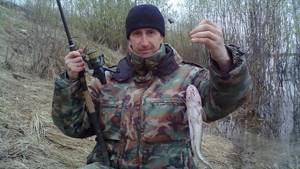
Immediately after the ice melts, you can start fishing using bottom gear. The best time for fishing is before the flood.
When the flood begins, the fish are distributed throughout the water area, and it is not easy to get to traditional fishing spots. During this period, many fishermen ignore catching fish .
The fishing location must be remembered according to coastal landmarks for subsequent catches. Due to the fact that burbot rarely changes its paths, even after a couple of years you can get an excellent catch in a proven place.

